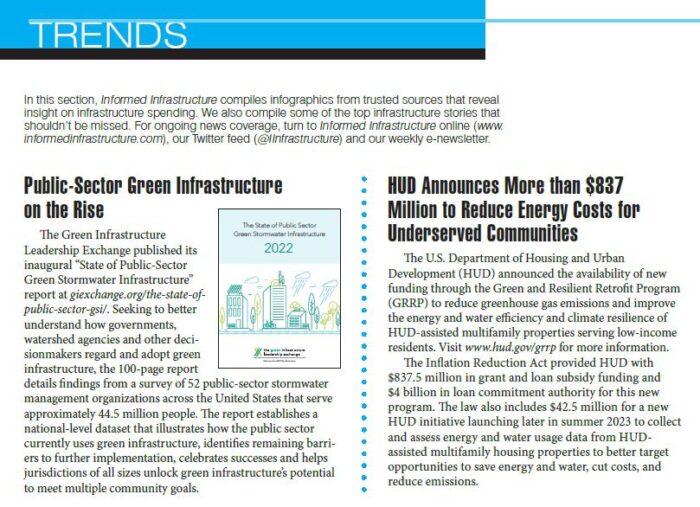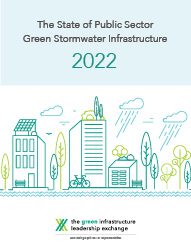Trends June 2023


The Green Infrastructure Leadership Exchange published its inaugural “State of Public-Sector Green Stormwater Infrastructure” report at giexchange.org/the-state-of-public-sector-gsi/. Seeking to better understand how governments, watershed agencies and other decisionmakers regard and adopt green infrastructure, the 100-page report details findings from a survey of 52 public-sector stormwater management organizations across the United States that serve approximately 44.5 million people. The report establishes a national-level dataset that illustrates how the public sector currently uses green infrastructure, identifies remaining barriers to further implementation, celebrates successes and helps jurisdictions of all sizes unlock green infrastructure’s potential to meet multiple community goals.
The U.S. Department of Housing and Urban Development (HUD) announced the availability of new funding through the Green and Resilient Retrofit Program (GRRP) to reduce greenhouse gas emissions and improve the energy and water efficiency and climate resilience of HUD-assisted multifamily properties serving low-income residents. Visit www.hud.gov/grrp for more information.
The Inflation Reduction Act provided HUD with $837.5 million in grant and loan subsidy funding and $4 billion in loan commitment authority for this new program. The law also includes $42.5 million for a new HUD initiative launching later in summer 2023 to collect and assess energy and water usage data from HUD-assisted multifamily housing properties to better target opportunities to save energy and water, cut costs, and reduce emissions.
The hydrogen market has progressed rapidly in recent years due to its growing application in industries such as the transport, industrial, energy, aerospace, defense and construction sectors. Against this backdrop, low-carbon hydrogen is gaining traction as a critical component to achieve energy-transition and long-term decarbonization goals, according to GlobalData, a data and analytics company.
The global demand for pure hydrogen stood at nearly 74 million metric tons per year in 2021, of which low-carbon hydrogen accounted for only 0.89 percent. Low-carbon hydrogen, including green hydrogen, has started to generate tremendous interest as a sustainable option to achieve long-term climate goals or net-zero targets.
GlobalData’s report, “Low-Carbon Hydrogen Market Report, Update 2023 – Global Market Outlook, Trends, and Key Country Analysis,” observes that during 2021-2022, the low-carbon hydrogen sector took major strides as several projects were announced as part of strategies toward energy transition. Download the full report at bit.ly/3BT2hW6.
Cutting Transport CO2 Now Reduces Investment Needs for Core Infrastructure
According to the International Transport Forum (ITF) “Transport Outlook 2023” report recently presented at the Organisation for Economic Co-operation and Development (OECD) global Summit in Leipzig, Germany, an ambitious transition to sustainable transport could be cheaper in terms of investment into core transport infrastructure than continuing as is—if action is taken now.
All transport decarbonization measures currently in place and already committed to will reduce global transport-related CO2 emissions by only 3 percent by 2050, and the transport sector would miss by a wide margin the reduction needed to keep climate change in check. However, if action to decarbonize transport is ratcheted up and accelerated, the transport sector can still reduce its CO2 emissions by about 80 percent during the next 25 years (compared to 2019).
This drop would put transport on the right path for limiting the global temperature increase to “well below” 2 degrees Celsius above pre-industrial levels, the goal of the Paris Climate Agreement.
For more information, visit www.itf-oecd.org.
TOP Stories
The following are the top stories from the last few months (in terms of traffic) on the Informed Infrastructure website. This also reflects key coverage areas that are regularly refreshed online and via our weekly e-newsletter. Simply search key words on Informed Infrastructure online to find the full story.
Buildings
- AISC Releases Buy Clean Guidance to Help Legislators Maximize Structural Steel’s Unmatched Sustainability
- Video: How to Build a Wood Skyscraper
- Bruynzeel: 90% CO2 Savings Possible on Buildings
- American Concrete Institute Publishes Code Requirements for Glass Fiber-Reinforced Polymer (GFRP) Bars
- PCA Introduces Updated RCC Design Manual
Transportation
- Novel Road Surfaces Could Be Key To Living With Climate Change
- California High-Speed Rail Authority Selects Atlas and Its JV Partners for $400 Million Program Management Contract
- Norwegian Public Roads Administration Selects Trimble for Asset Lifecycle Management
- Road to Resiliency: Episode 1 – Bad Things Were About to Happen
- USDOT Announces Two New Actions to Advance Economic Opportunity for Disadvantaged Workers and Businesses through the Bipartisan Infrastructure Law
Water
- Brown and Caldwell to Design the Replacement of Critical Southern California Water Pipeline
- 120Water Platform Selected to Manage Indiana Lead Service Line Database
- Elevate Your Standards in 2023 With Standard Methods for the Examination of Water and Wastewater, 24th Edition
- Cleaning Contaminated Water With Flax Shives
- Awwa Releases Insights Report From Water 2050 Technology Think Tank
Tools and Technology
- Vectorworks, Inc. Announces New Cloud and Mobile Enhancements Built on Apple Technology
- Navigate New Waters with UltraMap 6.0
- HDR Creates Industry-First Customizable Multimodal Tool for Analyzing Airport Landside Traffic
- ALLPLAN and Solibri Facilitate Higher Quality Models for Optimum Buildability
- Vodafone Creates Country-Scale Digital Twins to Engineer Better Networks


